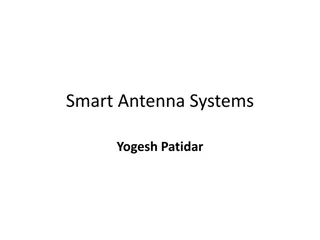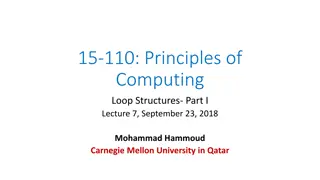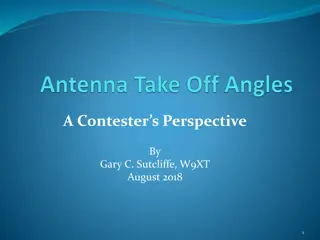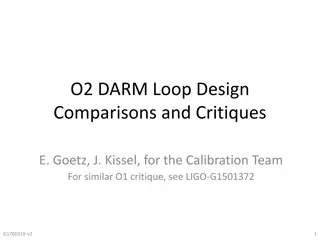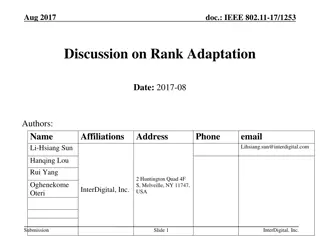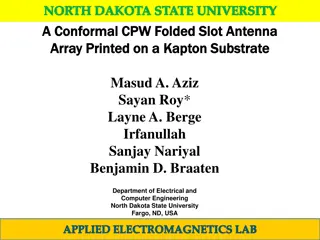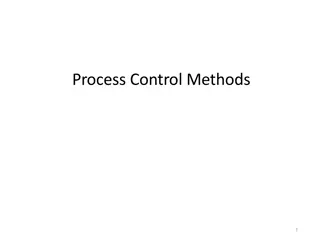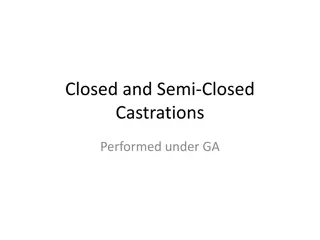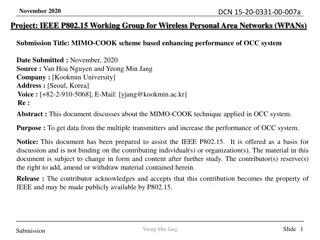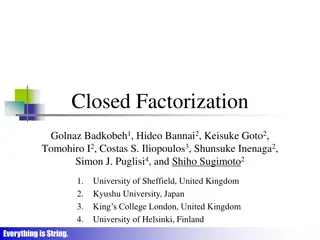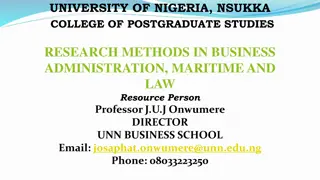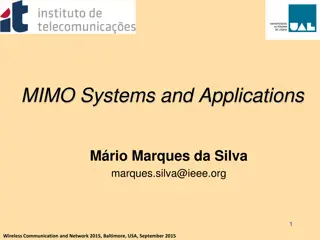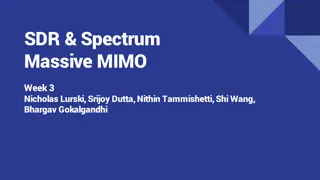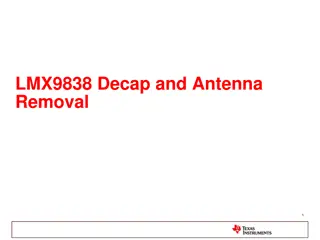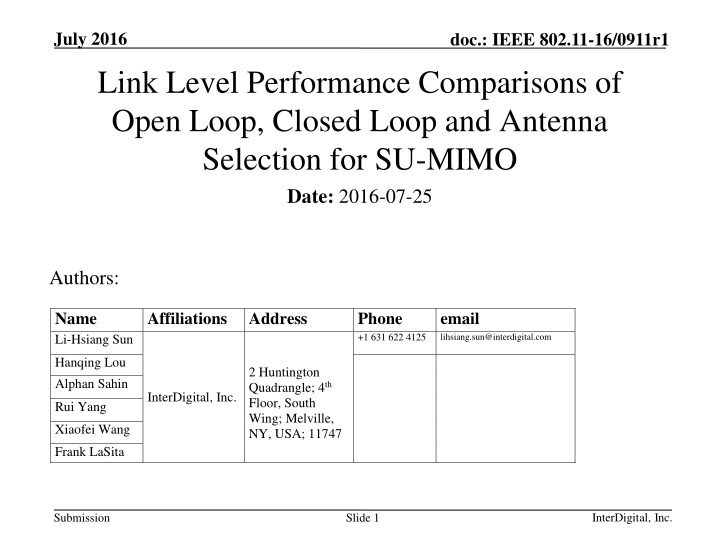
IEEE 802.11-16/0911r1 Link Level Performance Comparisons & Configurations
Explore the performance of open-loop, closed-loop, and antenna selection for SU-MIMO in IEEE 802.11-16/0911r1 document from July 2016. The study delves into baseband precoding methods, simulation assumptions, and simulated SU-MIMO configurations with beamforming implementations. Gain insights into the benefits of different configurations for SU-MIMO in wireless communication systems.
Download Presentation

Please find below an Image/Link to download the presentation.
The content on the website is provided AS IS for your information and personal use only. It may not be sold, licensed, or shared on other websites without obtaining consent from the author. If you encounter any issues during the download, it is possible that the publisher has removed the file from their server.
You are allowed to download the files provided on this website for personal or commercial use, subject to the condition that they are used lawfully. All files are the property of their respective owners.
The content on the website is provided AS IS for your information and personal use only. It may not be sold, licensed, or shared on other websites without obtaining consent from the author.
E N D
Presentation Transcript
July 2016 doc.: IEEE 802.11-16/0911r1 Link Level Performance Comparisons of Open Loop, Closed Loop and Antenna Selection for SU-MIMO Date: 2016-07-25 Authors: Name Li-Hsiang Sun Affiliations Address Phone +1 631 622 4125 email lihsiang.sun@interdigital.com 2 Huntington Quadrangle; 4th Floor, South Wing; Melville, NY, USA; 11747 Hanqing Lou Alphan Sahin InterDigital, Inc. Rui Yang Xiaofei Wang Frank LaSita InterDigital, Inc. Submission Slide 1
July 2016 doc.: IEEE 802.11-16/0911r1 Introduction TGay has agreed that 11ay will support SU-MIMO [1] In [2], we have shown 11ay system throughput benefits from CL SU-MIMO, using theoretical achievable sum rate. Still further studies are required to see whether benefits exist for SU-MIMO with equal MCS among spatial streams with single CRC. In this contribution, we performed SU-MIMO link level simulations based on 11ay channel model for analog beamforming, and baseband open loop, closed loop, antenna selections precoding as a follow-up study. InterDigital, Inc. Submission Slide 2
July 2016 doc.: IEEE 802.11-16/0911r1 Baseband Precoding Methods Open loop: Use the first Nss columns of an orthogonal matrix as precoding matrix cross all antennas* No channel knowledge needed at transmitter Closed loop: Use SVD based on the time domain channel matrix of the strongest path Full Channel State Information (CSI) knowledge at transmitter Antenna selection: Select the best Nss Tx antennas which gives the best total Rx power Partial CSI knowledge at transmitter * One PAA with dual polarization is considered as two antennas InterDigital, Inc. Submission Slide 3
July 2016 doc.: IEEE 802.11-16/0911r1 Simulation Assumptions Based on 11ad SC PHY Spatial stream parser: Stream 1 3.0 m b1 b3 b5 Encoder Output Bits b1 b2 b3 b4 b5 b6 window Stream 2 b2 b4 b6 MCS index is the same for all streams per PPDU, single CRC per PPDU MMSE receiver Conference room (CR) scenario in 11ay/ad channel model STAs are randomly placed on a 1 2.5 m table in the center of the CR, 1m above the floor AP is positioned at x=1.5, y=0.5, z=0.1m below the ceiling Ideal channel estimation at receiver Detailed assumptions can be found in the appendix STA 8 STA 3 STA 7 4.5 m STA 4 STA 1 STA 5 STA 2 STA 6 y AP (in ceiling) 0 door x 0 InterDigital, Inc. Submission
July 2016 doc.: IEEE 802.11-16/0911r1 Simulated SU-MIMO Configurations Beamforming implemented in all configurations Analog beamforming: Using phase shifter at each antenna to align Tx and Rx beams Digital beamforming: Spatial streams are precoded (as described in slide Baseband Precoding Methods ) and distributed to all antennas We simulated the following SU-MIMO PAA configurations [3] Configuration #2 2x2 channel, 1 PAA with dual polarization, on each side Configuration #4 4x4 channel, 2 PAAs with dual polarization on each side Configuration #4 @Tx, Configuration #2 @Rx 4x2 channel, 2 PAAs with dual polarization on Tx side, 1 PAA with dual polarization on Rx side Each element has dual polarization V and H pol E Phase shifter V pol Signal 1st stream PAA element Signal 2nd stream H pol Phase shifterV pol Distance between array centers - d Signal 3rd stream PAA element Signal 4th stream H pol Phase shifterV pol PAA element Signal 1st stream Signal 2nd stream PAA #2 H pol PAA #1 H and V pol H and V pol InterDigital, Inc. Submission Slide 5
July 2016 doc.: IEEE 802.11-16/0911r1 TX Conf #4/RX Conf #2, Nss=2, AP-STA PER performance for CL is significantly better than OL In OL, the signals of the same polarization from different Tx PAAs cause interference at RX, while in CL, these signals are combined coherently at RX. Rx Tx Phase shifterV pol Distance between array centers - d Signal 3rd stream Each element has dual polarization PAA element V and H pol Signal 4th stream E H pol Phase shifterV pol PAA element Signal 1st stream Signal 2nd stream PAA #2 Phase shifterV pol H pol Signal 1st stream PAA element PAA #1 Signal 2nd stream H and V pol H pol H and V pol InterDigital, Inc. Submission Slide 6
July 2016 doc.: IEEE 802.11-16/0911r1 Conf #2, Nss=1, STA-STA PER performance for CL and antenna selection are better than OL Virtual channel after analog beamforming provides enough spatial/polarization separation CL is slightly better than antenna selection however it requires much more channel knowledge In this case the number of stream is less than the rank of the channel. There is extra degree of freedom for CL to explore Tx Rx Each element has dual polarization Each element has dual polarization V and H pol V and H pol E E Phase shifterV pol Phase shifter V pol Signal 1st stream Signal 1st stream PAA element PAA element Signal 2nd stream Signal 2nd stream H pol H pol InterDigital, Inc. Submission Slide 7
July 2016 doc.: IEEE 802.11-16/0911r1 Conf #2, Nss=2, STA-STA CL and OL have similar PER performances The channels between different polarizations are close to orthogonal. The OL/CL have similar performance when Nss is equal to the rank of the channel In this case the number of stream is the same as the rank of the channel. There is no extra degree of freedom for CL to explore. Tx Rx Each element has dual polarization V and H pol Each element has dual polarization V and H pol E E Phase shifterV pol Signal 1st stream Phase shifterV pol PAA element Signal 1st stream PAA element Signal 2nd stream Signal 2nd stream H pol H pol InterDigital, Inc. Submission Slide 8 Slide 8
July 2016 doc.: IEEE 802.11-16/0911r1 Conf #4, Nss=2, STA-STA CL and antenna selection are significantly better than OL Virtual channel after analog beamforming provides some spatial/polarization separation CL is slightly better than antenna selection however it requires much more channel knowledge In this case the number of stream is less than the rank of the channel. There is extra degree of freedom for CL to explore Tx Rx Phase shifterV pol Distance between array centers - d Phase shifterV pol Signal 3rd stream Distance between array centers - d Signal 3rd stream PAA element PAA element Signal 4th stream Signal 4th stream H pol H pol Phase shifterV pol Phase shifterV pol PAA element Signal 1st stream PAA element Signal 1st stream Signal 2nd stream Signal 2nd stream PAA #2 PAA #2 H pol H pol PAA #1 PAA #1 H and V pol H and V pol H and V pol H and V pol InterDigital, Inc. Submission Slide 9
July 2016 doc.: IEEE 802.11-16/0911r1 Conclusion We demonstrated that CL SU-MIMO achieves up to 20 dB performance gain compared to OL SU-MIMO, particularly for the case Ntx > Nss Antenna selection provides better performance for SU-MIMO than OL while requiring significantly less feedback than CL InterDigital, Inc. Submission Slide 10
July 2016 doc.: IEEE 802.11-16/0911r1 References 1. Carlos Cordeiro, Specification Framework for TGay , IEEE 802.11- 15/01358r4 Rui Yang, et al, Open Loop vs Closed Loop SU-MIMO for 11ay , IEEE doc. 11-15/0642r1 A. Maltsev, et al, Channel models for ieee 802 11ay , IEEE doc. 11- 15/1150r4 R. Maslennikov, et al, Implementation of 60 GHz WLAN Channel Model, IEEE doc. 11-10/0854r3. 2. 3. 4. InterDigital, Inc. Submission Slide 11
July 2016 doc.: IEEE 802.11-16/0911r1 APPENDIX InterDigital, Inc. Submission Slide 12
July 2016 doc.: IEEE 802.11-16/0911r1 AP/STA Orientation For STA-STA scenarios, STA are placed randomly at the same height on the conference room table. Each STA is randomly rotated around z- axis with LOS path not blocked For AP-STA scenario, STA is placed at a plane 1.9m below AP on the conference room table. Random rotation around z-axis between STA/AP. InterDigital, Inc. Submission Slide 13
July 2016 doc.: IEEE 802.11-16/0911r1 Channel parameters Ray generation between each TX/RX PAA pair is based on the parameters in Table 2 of [4], with exception of LOS probability set to 1 For SU-MIMO configuration #2, TX/RX analog beamforming for both polarizations are based on the LOS direction Each PAA has 2x8 elements For SU-MIMO configuration #4, TX/RX analog beamforming for both polarizations of PAA#i are based on the LOS direction between TX PAA#i RX PAA#i Each PAA has 2x8 elements For SU-MIMO TX configuration #4 and RX configuration #2 TX analog beamforming for both polarizations of PAA#i are based on the LOS direction between TX PAA#i RX PAA#1 RX analog beamforming for both polarizations of PAA#1 are based on the direction between RX PAA#1 middle point of TX PAAs TX PAA has 2x8 elements RX PAA has 2x2 elements Channel bandwidth 1.76 GHz, center frequency 60GHz Distance between antenna elements 0.0025m Distance between center of PAAs 10cm InterDigital, Inc. Submission Slide 14

